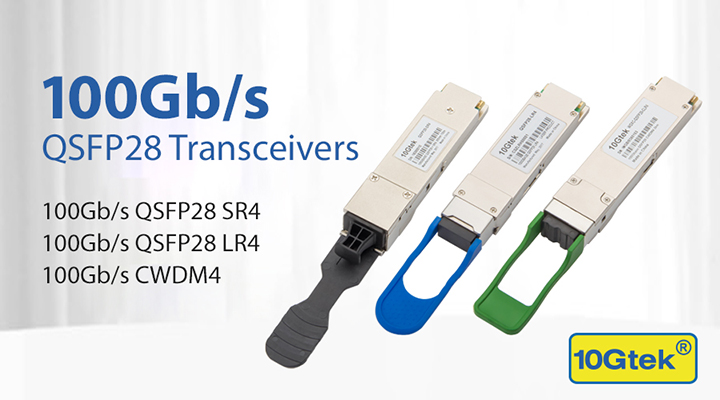100G QSFP28 Transceivers, Which Is Needed for Your Networking Infrastructure?

The 100G QSFP28 modules are the most popular 100G transceivers on the market today. Among many factors, this is primarily due to their low production cost, efficient size, and high output. This article is going to go over the specs, versions and details that make the QSFP28 market giant that it is today.
10Gtek currently manufactures mainly 4 modules of the 100GB QSFP28: SR4, LR4, CWDM4, and IR4 PSM. Let's look at what each one provides.
QSFP28 SR4

The runt of the 100GB transceivers is the the SR4. While SR stands for “short range” the transceiver still outputs the same 100GB/s speeds as the other drives. QSFP28 SR4 transceiver uses an MTP/MPO interface, using a multi-mode cable for short distances. Both the IR4 PSM and the SR4 use a 12-fiber MTP/MPO patch cable. The advantage of the SR4 is its economical price point. While it doesn't have the longest distance, it does provide the same top quality speed, only for a fraction of the cost of the higher-end modules. And like all 10Gtek modules, it is fully tested on Cisco & Accton devices for application. 10Gtek has SR4s in-stock and ready for delivery.
QSFP28 LR4

The top end of the QSFP28 product line is the LR4. The LR4 is a full duplex LC module that provides everything you could want in a transceiver. The duplex function allows the LR4 to work as both a transmit and receive path in one module. On the transmit side, 4 lanes of high-end optical signals push out over a staggering 25GBps per lane. On the receive side, the 4 lanes can de-multiplex data streams with a fully integrated de-multiplexer, transforming that data into CAUI-4 electric output. The module has a maximum link length of 10km and operates on 1 single-mode fiber cable with duplex LC connector. All 10GTek LR4 modules have been fully tested on Cisco & Accton devices to make sure they work on your system. This is the best of the line in 100GB transceivers from 10GTek. We always have them in-stock and provide lightning fast delivery.
QSFP28 CWDM4
.jpg)
Along with the LR4, the CWDM4 is another full duplex LC module. Along with the LR4, it pushes out over 100GB from its 4 lanes of high-end optical transmitters and de-multiplexes with the same fully integrated de-multiplexer. The advantage of both the LR4 and CWDM4 modules is the easy of which upgrading can be done. Both modules run on common single-mode duplex LC patch cable requiring no need to replace all of those fiber patch cables. That saves money, headaches and downtime with trying to replace all of that cable. You can also save space with removable “push-pull” tabs. Like all 10GTek modules, it is fully tested on Cisco & Accton devices. The main difference between the CWDM4 to the LR4 is the maximum link length with the CWDM4 having a max length of 2km, suitable for most common demands.
QSFP28 IR4 PSM
.jpg)
Moving from our duplex LC modules, we get the IR4 Parallel Single Mode Transceiver. The IR4 is an MTP/MPO interface transceiver with 4 independent full-duplex lanes. Along with its LC brothers, it puts out at over 25GB/s per transmit lane and converts input signals with its parallel optical receiver lanes. The transceiver accepts input signals compatible with Common Mode Logic (CML) levels. You also don't need to sacrifice distance with a 2km range. The IR4 PSM uses single-mode cable meaning it can work over long distances. Like all 10Gtek modules, it is fully tested on Cisco & Accton devices. The IR4 PSM is a great choice for customers that don't want to upgrade to the more expensive LC modules but still high quality speed and distance.
All 3rd party compatible transceivers made by 10Gtek are 100% tested on Cisco, Accton switches, one by one, before shipment. For orders, questions and inquiries on these products or any of the other 10Gtek product line, please feel free to contact us at info@10gtek.com/+86 755 2998 8100. Our friendly and knowledgeable customer service agents are ready to take your calls.
Related articles:



